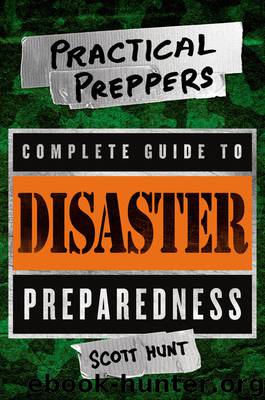The Practical Preppers Complete Guide to Disaster Preparedness by Scott Hunt

Author:Scott Hunt [Hunt, Scott]
Language: eng
Format: epub
ISBN: 9781466859241
Publisher: St. Martin's Press
MY DIESEL GENERATOR
I am a fan of diesel generators that run at 1800 rpms because they typically have the longest service life. They also allow you more fuel options as we discussed (here).
Overall, generators are great tools to weather a storm. My personal setup has provided clean electricity for over 1,600 hours or over two months’ worth of 24/7 power. During one ice storm I ran my diesel generator for seven days straight. It is a 2-cylinder diesel running at 1800 rpms. I find that a 2–3 cylinder 12,000-watt diesel generator strikes a good balance between having plenty of power and great fuel economy. I run twenty-four hours on eight gallons of diesel. Many residential standby systems use about 1.5 gallons per hour, or thirty-six gallons a day. That is quite a difference. You need to plan your expected time of usage and your storage accordingly. Make sure you can easily start and stop your generator. This allows you to run it only when necessary and greatly conserves your fuel supply.
Batteries
Batteries are energy-storage devices and instead of talking about them in the fuel-storage section I wanted them sandwiched between generators and photovoltaic (or solar) systems as they are the two most widely used methods for charging batteries in a grid-down situation. The batteries I will mention start with the small 50-cent coin batteries and will progress to a $40,000 Ni-FE 48 volt off-grid battery bank that will last a lifetime.
Stocking up on batteries is a must. Once you start practicing using your preparations you start to realize how many batteries you need. Batteries and battery-operated devices allow you to have effective defensive measures. There are many combat or force multipliers that rely on battery power. Without them you will need a lot more manpower and thus a lot more food and supplies to take care of them. I always say that it is a lot cheaper to feed those Dakota Alerts batteries than five to ten grown men sitting out on the perimeter.
Make it a priority to standardize your equipment as much as possible to minimize the different types of batteries you need. For our retreat, AA and CR123s are the mainstays. They are used in radios, alarms, transmitters, laser aiming systems, night vision, flashlights, driveway probes, cameras, and video cameras. I try to get good rechargeable batteries for as many devices as possible. I have had good success with Sanyo Eneloops and Tenergy rechargeables. Of course you also need good chargers and some spares.
Lithium ion batteries are very much a part of our gadget world today from cell phones to laptops to power tools and electric vehicles. I have found the new external lithium-ion battery packs very handy to charge or run anything you can plug into them. In remote places or when traveling they have kept my cell phone and tablet going for the day without access to the grid. They can also be recharged with solar. I like charging DC-DC as it is more efficient then having inverters and transformers in the loop.
Download
This site does not store any files on its server. We only index and link to content provided by other sites. Please contact the content providers to delete copyright contents if any and email us, we'll remove relevant links or contents immediately.
Man-made Catastrophes and Risk Information Concealment by Dmitry Chernov & Didier Sornette(5862)
The Revenge of Geography: What the Map Tells Us About Coming Conflicts and the Battle Against Fate by Kaplan Robert D(3979)
Zero Waste Home by Bea Johnson(3708)
COSMOS by Carl Sagan(3495)
In a Sunburned Country by Bill Bryson(3438)
Good by S. Walden(3437)
The Fate of Rome: Climate, Disease, and the End of an Empire (The Princeton History of the Ancient World) by Kyle Harper(2967)
A Wilder Time by William E. Glassley(2780)
Camino Island by John Grisham(2731)
Organic Mushroom Farming and Mycoremediation by Tradd Cotter(2596)
The Ogre by Doug Scott(2593)
Human Dynamics Research in Smart and Connected Communities by Shih-Lung Shaw & Daniel Sui(2437)
Energy Myths and Realities by Vaclav Smil(2399)
The Traveler's Gift by Andy Andrews(2319)
9781803241661-PYTHON FOR ARCGIS PRO by Unknown(2286)
Inside the Middle East by Avi Melamed(2271)
Birds of New Guinea by Pratt Thane K.; Beehler Bruce M.; Anderton John C(2199)
A History of Warfare by John Keegan(2129)
Ultimate Navigation Manual by Lyle Brotherton(2073)
